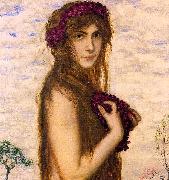
Oil On
Canvas, Real Flavor of Old Masters
|
Sir Edward Coley Burne-Jones
|
|||
|
|
|||
| British Pre-Raphaelite Painter, 1833-1898 English painter and decorative artist. He was the leading figure in the second phase of the Pre-Raphaelite movement. His paintings of subjects from medieval legend and Classical mythology and his designs for stained glass, tapestry and many other media played an important part in the Aesthetic Movement and the history of international Symbolism. | |||
|
|
|||
|
|
Spring Sir Edward Coley Burne-Jones7.jpg Painting ID:: 279 Visit European Gallery |
1869-70 | |
Height Width |
INS/CM |
||
|
X |
|
||
|
|
|||
|
Franz von Stuck
|
|||
|
|
|||
| German Symbolist/Expressionist Painter and Sculptor, 1863-1928 Stuck was born at Tettenweis, in Bavaria. From an early age he displayed an affinity for drawing and caricature. To begin his artistic education in 1878 he went to Munich, where he would settle for life. From 1881 to 1885 Stuck attended the Munich Academy. He first made a name with cartoons for Fliegende Blätter, and vignette designs for programmes and book decoration. In 1889 he exhibited his first paintings at the Munich Glass Palace, winning a gold medal for The Guardian of Paradise. In 1892 Stuck co-founded the Munich Secession, and also executed his first sculpture, Athlete. The following year he won further acclaim with the critical and public success of what is now his most famous work, The Sin. Also in 1893, Stuck was awarded a gold medal for painting at the Chicago World's Fair and was appointed to a royal professorship. In 1895 he began teaching painting at the Munich Academy. In 1897 Stuck married an American widow, Mary Lindpainter, and began work designing his own residence and studio, the Villa Stuck. His designs for the villa included everything from layout to interior decorations; for his furniture Stuck received another gold medal at the 1900 Paris World Exposition. Having attained a high degree of fame by this time, Stuck was elevated to the aristocracy on December 9, 1905 and would receive further public honours from around Europe during the remainder of his life. Even as new trends in art left Stuck behind, he continued to be highly respected among young artists in his capacity as professor at the Munich Academy. Notable students of his over the years include Paul Klee, Hans Purrmann, Wassily Kandinsky, and Josef Albers. Franz von Stuck died in 1928; his funeral address memorialized him as "the last prince of art of Munich's great days". He is buried in the Munich Waldfriedhof next to his wife Mary. | |||
|
|
|||
|
|
Spring Franz von Stuck6.jpg Painting ID:: 3717 Visit European Gallery |
1912 Hessisches Landesmuseum, Darmstadt | |
Height Width |
INS/CM |
||
|
X |
|
||
|
|
|||
|
Burne-Jones, Sir Edward Coley
|
|||
|
|
|||
| British Pre-Raphaelite Painter, 1833-1898 English painter and decorative artist. He was the leading figure in the second phase of the Pre-Raphaelite movement. His paintings of subjects from medieval legend and Classical mythology and his designs for stained glass, tapestry and many other media played an important part in the Aesthetic Movement and the history of international Symbolism. | |||
|
|
|||
|
|
Spring new3/Burne-Jones, Sir Edward Coley_VG7GQW.jpg Painting ID:: 18892 Visit European Gallery |
1869-70, gouache, private collection | |
Height Width |
INS/CM |
||
|
X |
|
||
|
|
|||









